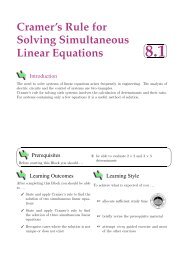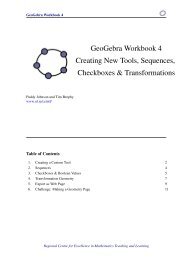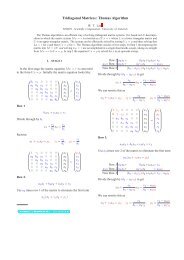Student Notes To Accompany MS4214: STATISTICAL INFERENCE
Student Notes To Accompany MS4214: STATISTICAL INFERENCE
Student Notes To Accompany MS4214: STATISTICAL INFERENCE
You also want an ePaper? Increase the reach of your titles
YUMPU automatically turns print PDFs into web optimized ePapers that Google loves.
Example 1.2 (Tuberculosis). Suppose we are going to examine n people and record<br />
a value 1 for people who have been exposed to the tuberculosis virus and a value 0<br />
for people who have not been so exposed. The data will consist of a random vector<br />
X = (X1, X2, . . . , Xn) where Xi = 1 if the ith person has been exposed to the TB virus<br />
and Xi = 0 otherwise.<br />
A Bernoulli random variable X has probability mass function<br />
P (X = x|θ) = θ x (1 − θ) 1−x , (1.2)<br />
for x = 0, 1 and θ ∈ (0, 1). A possible model would be to assume that X1, X2, . . . , Xn<br />
behave like n independent Bernoulli random variables each of which has the same<br />
(unknown) probability θ of taking the value 1.<br />
Let x = (x1, x2, . . . , xn) be a particular vector of zeros and ones. Then the model<br />
implies that the probability that the random vector X takes the value x is given by<br />
P (X = x|θ) =<br />
n�<br />
θ xi 1−xi (1 − θ)<br />
i=1<br />
= θ �n i=1 xi n−<br />
(1 − θ) �n i=1 xi .<br />
Once again our plan is to use the value x of X that we actually observe to learn<br />
something about the value of θ. �<br />
Example 1.3 (Viagra). A chemical compound Y is used in the manufacture of Viagra.<br />
Suppose that we are going to measure the micrograms of Y in a sample of n pills. The<br />
data will consist of a random vector X = (X1, X2, . . . , Xn) where Xi is the chemical<br />
content of Y for the ith pill.<br />
A possible model would be to assume that X1, X2, . . . , Xn behave like n independent<br />
random variables each having a N (µ, σ 2 ) density with unknown mean parameter µ ∈ R,<br />
(really, here µ ∈ R + ) and known variance parameter σ 2 < ∞. Each Xi has density<br />
fXi (xi|µ) =<br />
1<br />
√ 2πσ 2 exp<br />
�<br />
− (xi − µ) 2<br />
2σ 2<br />
Let x = (x1, x2, . . . , xn) be a particular vector of real numbers. Then the model implies<br />
the joint density<br />
fX(x|µ) =<br />
=<br />
n�<br />
i=1<br />
�<br />
.<br />
1<br />
√<br />
2πσ2 exp<br />
�<br />
− (xi − µ) 2 �<br />
1<br />
( √ 2πσ2 exp<br />
) n<br />
�<br />
−<br />
2σ 2<br />
� n<br />
i=1 (xi − µ) 2<br />
2σ 2<br />
Once again our plan is to use the value x of X that we actually observe to learn<br />
something about the value of µ. �<br />
5<br />
�






